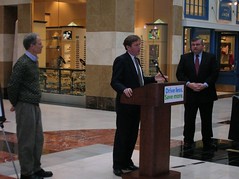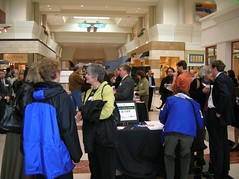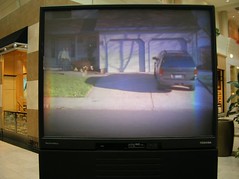Transportation wonks were out in force (this wonk virtuously carpooled) yesterday as Metro, TriMet, ODOT and Washington County announced a public information campaign to encourage folks to take a little control over their auto trips. The message is not wholesale change, but rather an incremental approach: avoid 1 or 2 auto trips a week – or shift them to another mode – and you can have a big positive impact on the transportation system, and on your wallet.
Transportation wonks were out in force (this wonk virtuously carpooled) yesterday as Metro, TriMet, ODOT and Washington County announced a public information campaign to encourage folks to take a little control over their auto trips. The message is not wholesale change, but rather an incremental approach: avoid 1 or 2 auto trips a week – or shift them to another mode – and you can have a big positive impact on the transportation system, and on your wallet.
The program, consisting primarily of a set of short TV commercials, will run as a pilot for 2 years, and then roll out statewide if successful.
I think it’s worth a try. Compare it to the way we do recycling in this state – everyone participates, at least a little bit.
Check out more details at http://drivelesssavemore.com.



3 responses to “A Report from the Drive Less Save More Event”
Thanks for the coverage, Chris. We are excited about the launch of this campaign. It’s the first time that we’ve really had the ability to talk to Oregonians about how they use their cars. I’m optimistic that we’ll be able to make some headway on that front. We’re starting with a modest goal – something easy and that practically everyone can do – but we intend to broaden our message over time to encourage people not only to use their cars a bit less via trip chaining, but to also take advantage of the other transportation options available to them.
It’s great to see the word getting out about making conscious choices to reduce congestion and environmental effects – kudos to all working on this.
I wish I could offer the same to the Oregonian’s article (http://www.oregonlive.com/search/index.ssf?/base/news/1138854320181520.xml?oregonian?lcfp&coll=7), but it was – to use a technical term – lame.
The first 3 paragraphs give a helpful summary, but the remaining 3/4 of the piece are devoted to people saying, essentially, “Naw, it’s too hard.”
The first quote – “The only way I think it would be possible is if a store made it more convenient — if there were a superstore, with movies and one-stop shopping.” Hello? Has Fred Meyer not made it out west yet?
We’re talking baby-steps here people. 1 or 2 trips a week. I imagine a similar response from the first people to hear about curb-side recycling: “Use a trash barrel *and* two bins? It’ll never work. I don’t have time to figure that out.”
I believe that our friends in the transit-unfriendly reaches of Beaverton and beyond have definite challenges with regards to reducing vehicle miles travelled. But this article gives them no credit for being able to make even the smallest effort toward surmounting those obstacles.
Best of luck to the Drive Less/Save More crew! You have my support, if not the big O’s.
The main media slant on this is that it’s promoting trip-chaining. Are people actually trip-chaining less than they used to? Is there evidence (e.g., personal transportation surveys) about people’s travel habits that gets to the heart of the problem here?
I just don’t get this. We are rolling out a $2-million campaign to ask people to do something that is, in every way, in their own self-interest, and that they probably do already. Is it possible that people are already trip-chaining, but the problem is they want to live in Sherwood and work in Beaverton and shop at Bridgeport Village, and so on? That’s a different problem that isn’t solved by this campaign.
I think the quote from the “one-stop shopping” lady in the Oregonian article is more revealing than we’re giving her credit for. She’s making a totally rational decision about how to get around, even if that decision causes her own time, money, and health problems, and traffic congestion, air pollution, and crap urban design for the rest of us.